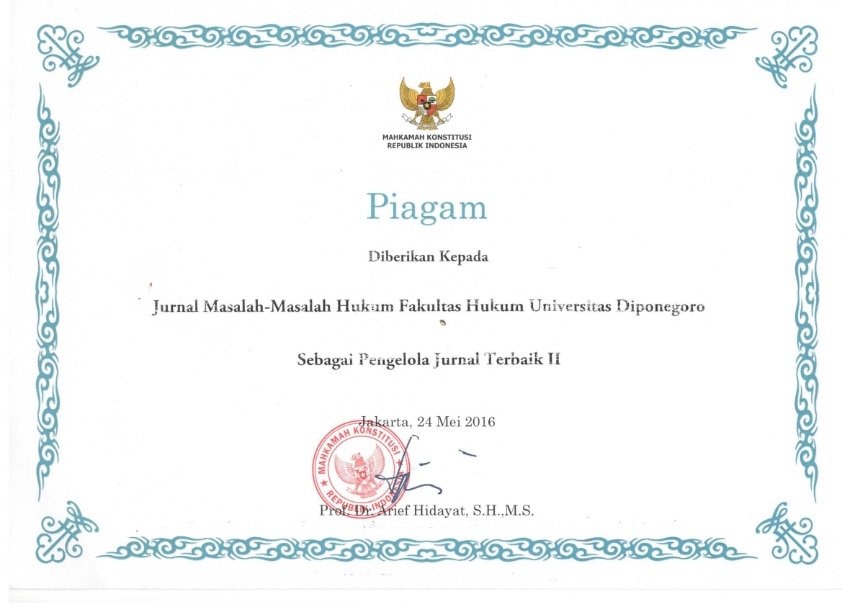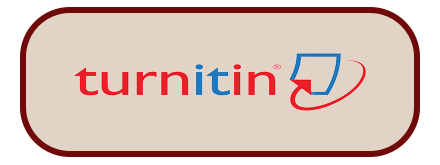Submission and Author Guideline
Masalah-Masalah Hukum
2020
A. General Information
1. Generally, article should be written in with font: times new roman, font size: 12, single spacing,
2. Each article should be accompanied by the following information:
a. The title of the article, the title is written in Times New Roman, size: 14 pt, style: Bold, Centre and Uppercase, Maximum 14 words. Exclusively for research article, the article should be informed research identity in footnote format.
b. The author’s name (write full name of the author without any qualifications), affiliation and institutional address, and email. That information should be written in small caps, starting with capital letters with single line spacing.
e.g:
Aditya Yuli Sulistyawan
Fakultas Hukum, Universitas Diponegoro
Jl. Prof. Soedarto, SH , No. 1, Tembalang, Semarang
adityayuli38@gmail.com
3. The number of author could be more than 1 by adding comma ( , ). The correspondent author should be marked as “ * “. Corresponding author clearly indicate who will handle correspondence at all stages of refereeing and publication, also post-publication. Ensure that the e-mail address is given and that contact details are kept up to date by the corresponding author.
4. Research article should be between 10 and 12 pages, and for conceptual article should be between 7 and 10 pages. The number of pages included figures and tables.
5. Abstract should be provided both in Bahasa and English with single spacing in one paragraph with 100-125 words. For abstract that written in English, The title should be written in bold and the content of the abstract should be written in italic style. For abstract that written in Bahasa, it should be written in sentence case.
6. Keywords should be written immediately after the abstract, provide a maximum 3-5 words in lowercase with Times New Roman, font style: bold, alignment: justified.
7. Wikipedia and personal blog are not allowed to be used as article sources
B. Paper Format
This journal welcomes research article and conceptual article. Submission of an article implied that the work has not been published previously, that it is not under consideration for publication elsewhere.
1. Research Article
The guideline for research article as follows:
A. Introduction
Introduction should be clear and provide the issue to be discussed in the article. Introduction should be consist of the background, theory approach, state of the art, and gap analysis. At the end of the paragraph, the author should end with a comment on the significance concerning identification of the issue.
B. Research Method
The research method should be written in descriptive in two paragraphs.
C. Analysis and Discussion
This section is the most important section of the article. Contains the results of the object of study and should be clear and concise. This should explore the significance of the results of the work; avoid extensive citations and discussion of published literature.
D. Conclusion and Suggestion
The conclusion and suggestion may be presented in a short, which may stand alone or form a different section of a Analysis and Discussion section.
E. References
References at the end of the article should be written in American Psychological Association 6th Edition. Please use Reference Manager Mendeley. All publications cited in the text should be included as a list of Bibliography, arranged alphabetically by author. References that may be referred is all the publications in the last 10 (ten) years, except for certain references that have not been re-published/ the composition of the Bibliography should be 80% of national and international journal, thesis, and proceedings; 20% of the Bibliography is from books or others except Wikipedia and personal blog.
2. Conceptual Article
The guideline of conceptual article as follows:
A. Introduction
B. Result and Discussion
C. Conclusion
D. References
C. Quotations
For direct quotation with more than 4 lines should be in a separate paragraph with left indentation 1,27 cm, justified, and use single line spacing.
D. Bibliography
The bibliography should be written in the end of the articles, titled “Bibliography”, written in Times New Roman 12, single spacing and indent on the second line of each bibliography. If the sources are varied, it should be put into groups:
1. Legal documents
2. Books
3. Articles
4. Website
Please useAmerican Psychological Association 6th Edition for bodynote and bibliography (mendeley), as sample below:
1. One author
Author’s last name, author’s first name, year of publishing with (…), title of book (italic), city of publisher: publisher. Contoh:
Irianto, S. (2006). Memperkenalkan Studi Sosio Legal. Bandung: Yayasan Obor.
Rahardjo, S. (2006). Ilmu Hukum. Bandung: Citra Aditya Bakti.
2. Two authors
Kusnardi Muhammad., & Saragih, B. (1994). Susunan Pembagian Kekuasaan Menurut Undang-Undang Dasar 1945. Jakarta: Gramedia Pustaka Utama.
3. More than three authors or institution
Bank Indonesia. (2016). Optimizing Macroprudential Policy to Support the Financial Stability. Jakarta: Bank Indonesia.
World Bank. (2006). Decentralization and Subnational Regional Economics-What,Why and Where. World Bank.
4. Journal Article
Author’s last name, author’s first name, published time, title of article, name of journal and edition, page cited.
Saraswati, R. (2014). Arah Politik Hukum Pengaturan Desa ke Depan (Ius Constituendum). Jurnal Masalah-Masalah Hukum, Vol.43(No.3), pp.313-321.
Samekto, A. (2010). Pembangunan Berkelanjutan dalam Tatanan Sosial yang Berubah. Jurnal Hukum Progresif, Vol.1(Issue:2), p.15.
Hayat. (2014). Korelasi Pemilu Serentak Dengan Multi Partai Sebagai Penguatan Sistem Presidensiil. Jurnal Konstitusi, Vol.11(No.3, September), pp.461-469, 271.
5. Proceeding Article
Hidayat, A. (2012). Negara Hukum Pancasila (Suatu Model Ideal Penyelenggaraan Negara Hukum). In Prosiding Konggres Pancasila IV:Strategi Pelembagaan Nilai-Nilai Pancasila dalam Menegakkan Konstitusionalitas Indonesia (pp.56–65). Yogyakarta: PSP Press Universitas Gadjah Mada.
Harkes, I. (1999). An Institutional Analysis of Sasi Laut, a Fisheries Management System in Indonesia. In Proceedings of the International Workshop on Fisheries Co-Management (pp. 1–9). Netherlands: ICLARM.
6. Chapter or other part of a book
Author’s last name, author’s first name, years of publication, title of article, editors name (if any), title of the book, page cited, place of publication and publisher.
Irianto, S. (2009). Praktik Penelitian Hukum:Perspektif Sosiolegal. In Shidarta. & S. Irianto (Eds.), Metode Penelitian Hukum Konstelasi dan Refleksi (pp. 297–315). Jakarta: Yayasan Obor.
7. Newspaper
Author’s last name, author’s first name, years of publication, month and date, title of the article, name of newspaper.
Sukirno. (2014, Januari 16). Diskriminasi Masyarakat Adat. Harian Kompas.
Surbakti, R. (2016, September 22). Sistem Pemilu dan Konsekuensi. Harian Kompas.
8. Thesis
Hidayat, A. (2006). Kebebasan Berserikat di Indonesia: Suatu Analisis Pengaruh Perubahan Sistem Politik Terhadap Penafsiran Hukum. Universitas Diponegoro.
Roisah, K. (2013). Membangun Prinsip-Prinsip Perlindungan Hukum Kekayaan Intelektual Berbasis Kearifan Lokal (Studi Perlindungan Hukum terhadap Ekspresi Budaya Tradisional Indonesia. Universitas Diponegoro
9. Websites
Author’s last name, author’s first name, years of publication, title of the article, name of newspaper.
United Nations High Commissioner for Human Rights. (2016). Combating Discrimination Against Indigenous Peoples. Retrieved from http://www.ohchr.org/EN/Issues/Discrimination/Pages/discrimination_indigenous.aspx,accesed 15th April 2016.
E. Main Headings of Article
Following main headings should be provided in the article while preparing. Main headings, sub-headings and sub-sub headings should be numbered in the article with the following example:
A._____________________________________________________________
1.__________________________________________________________
a._____________________________________________________
1).________________________________________________
a).____________________________________________
(1)._______________________________________
(a)._________________________________
F. Figures and Tables
The figures should be clearly readable and at least have a resolution of 300 DPI (Dots Per Inch) for good printing quality. Table made with the open model (without the vertical lines).
Table 1. The Authority of The Judge
Column heading/name | Column A (t) | Column B (T) |
| 1 | 2 |
| 3 | 4 |
| 5 | 6 |
| | | | |













